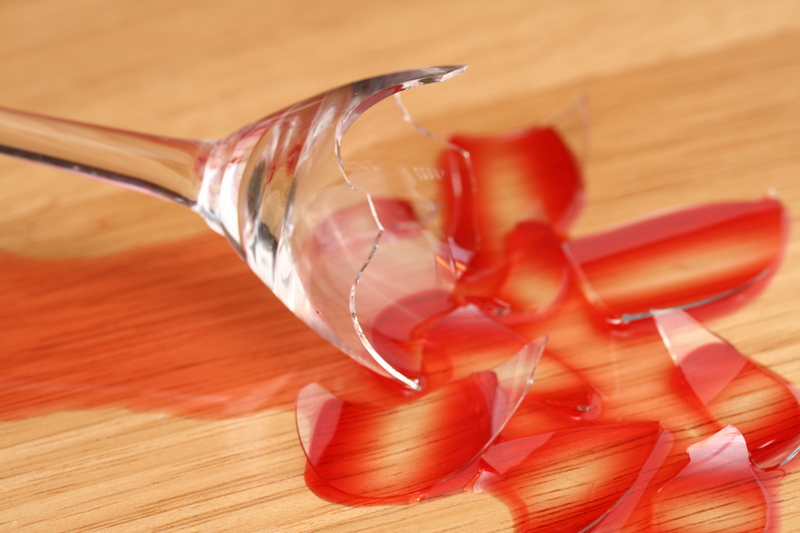Comprehensive Guide: End of Tenancy House Cleaning for Tenants
Posted on 30/08/2025
Comprehensive Guide: End of Tenancy House Cleaning for Tenants
Moving out of a rented property can be stressful for any tenant. One of the major responsibilities--often overlooked until the last minute--is the end of tenancy house cleaning. Whether you are seeking to recover your full security deposit or simply want to leave a positive impression on your landlord, a thorough end of lease cleaning is a must. In this comprehensive guide, we cover everything tenants should know about end of tenancy cleaning, including why it is essential, how to organize the process, and tips to achieve professional-level results.
Why is End of Tenancy House Cleaning Important?
Before diving into the practical steps of cleaning, it's important to understand the reasons behind the end of tenancy cleaning obligation:
- Ensures Full Deposit Return: Most tenancy agreements require tenants to return the property in the same condition as when the tenancy began, excluding normal wear and tear. Proper cleaning is a critical factor in getting your deposit back in full.
- Positive Reference from Landlord: A clean property can bolster your landlord's impression, which may result in a favorable reference for future rentals.
- Avoiding Disputes: Many tenant-landlord disagreements stem from cleaning issues. A professional, comprehensive clean minimizes the chances of disputes or further deductions.
- Legal Requirement: In some places, end of lease cleaning is a contractual or even statutory requirement outlined in your tenancy agreement or local regulations.

What Does End of Tenancy Cleaning Involve?
It's not just about vacuuming and dusting. End of tenancy house cleaning is a deep cleaning process from top to bottom. It covers every nook and cranny of the house or apartment, including:
- Living Areas: Carpets, floors, walls, windows, and skirting boards
- Kitchens: Appliances, cupboards, countertops, sinks, tiles, extractor fans
- Bathrooms: Toilets, showers, bathtubs, washbasins, mirrors, tiles, fittings
- Bedrooms: Wardrobes, baseboards, furniture, floors, windows
- Outdoor Spaces: Balconies, patios, gardens, driveways (if applicable)
Checklist: End of Lease Cleaning Tasks
- Remove all personal items and rubbish from the property
- Clean all floors (vacuum, mop, and treat stains as necessary)
- Wash and wipe down all surfaces, including walls and baseboards
- Clean doors, handles, light switches, and skirting boards
- Wash windows (inside and sometimes outside)
- Clean kitchen appliances inside and out (oven, microwave, refrigerator, etc.)
- Descale sinks, taps, and bathroom surfaces
- Scrub toilets, showers, bathtubs, and tile grout
- Clean mirrors, shelves, and cabinets (inside and out)
- Dust light fixtures, ceiling fans, and blinds
How to Prepare for Your End of Contract Clean
1. Review Your Tenancy Agreement
Before you begin, check the cleaning requirements outlined in your tenancy agreement. Landlords and letting agencies often have specific expectations about the standard and scope of the cleaning. For instance, some may require professional carpet cleaning or demand receipts for certain services.
2. Create a Cleaning Plan & Schedule
A deep clean can be overwhelming if tackled without a plan. To ensure you don't miss any critical detail:
- List every room and its cleaning requirements
- Gather cleaning supplies in advance
- Assign cleaning tasks and allocate time
- Enlist help from friends, family, or hire professionals if required
3. Inspect for Repairs
Part of a successful end of tenancy move out cleaning is ensuring the property is free not only of dirt but also of damage (aside from fair wear and tear). Check for:
- Nail holes or wall damage
- Broken fixtures or fittings
- Stained carpets or upholstery
- Overlooked maintenance issues
Addressing these issues before the final cleaning could prevent deductions from your security deposit.
DIY End of Tenancy Cleaning vs. Professional Cleaning Services
You have the option to either complete the house move-out cleaning yourself or hire a professional cleaning company. Here's a look at the advantages and drawbacks of both:
DIY End of Tenancy Cleaning
Pros:- Cost-effective
- Flexible schedule
- Control over the products used (handy for allergies or preferences)
- Time-consuming and physically demanding
- Risk of overlooking specific requirements
- Lacks professional-grade equipment for deep stains
Professional End of Tenancy Cleaning Services
Pros:- Professional results that meet landlord/agency standards
- Saves significant time and effort
- Often comes with a service guarantee or cleaning certificate (sometimes required by landlords)
- Use of commercial-grade cleaning products and equipment
- Additional expense
- Must coordinate timings with cleaners and your move-out date
- May need to be present for access and review
Room-by-Room End of Tenancy Cleaning Guide
Kitchen Cleaning Tips
- Degrease & Clean Appliances: Clean oven, stovetop, extractor, and microwave. Remove racks and trays for soaking.
- Empty & Wash Fridge/Freezer: Defrost freezer, wipe all surfaces, and leave doors open to prevent mold.
- Scrub Cupboards: Clear out all cupboards, wipe inside and out, and check for food residue.
- Sanitize Sink & Surfaces: Remove stains, limescale, and polish taps and sinks.
- Mop Floors & Clean Tiles: Pay special attention to grout and tile edges where grease accumulates.
Bathroom Cleaning Tips
- Descale Surfaces: Use limescale remover on taps, shower heads, and tiles.
- Scrub Toilet: Clean bowl, seat, lid, and exterior. Use disinfectant for hygiene.
- Wash Mirrors & Fixtures: Polish glass and chrome for a streak-free finish.
- Empty Bins: Replace liners and ensure the area is odor-free.
- Sanitize Floors: Mop and treat any mold or mildew present.
Bedroom & Living Area Cleaning Tips
- Dust All Surfaces: Don't forget skirting boards, window sills, and fitted furniture.
- Clean Carpets & Rugs: Vacuum thoroughly, and consider steam cleaning for deep stains.
- Wash Windows: Inside and out, including tracks and ledges.
- Empty & Clean Wardrobes: Remove all belongings and wipe interior shelves.
- Spot Clean Walls: Clean off marks, cobwebs, and fingerprints.
Outdoor and Miscellaneous Areas
- Remove Rubbish: Clear out bins and unwanted items.
- Sweep Patios or Balconies: Remove leaves and litter.
- Garage/Shed: Clear, sweep, and wipe down as needed.
Items Often Missed During End of Lease Cleaning
Even with the most detailed plans, some spots are commonly overlooked. Make sure you include these in your cleaning routine:
- Extractor fan covers
- Behind and under large appliances
- Window sills and tracks
- Skirting boards and door frames
- Radiators (top and behind)
- Light fittings and ceiling fans
- Plug sockets and switches
- Bathroom fans and vents
What Landlords and Agents Inspect After Move-Out
Your landlord or agent usually conducts a final inspection based on the property's original inventory. They look for cleanliness, property damage, and missing items. Keep a copy of the inventory or take 'before and after' pictures for your records--this can be crucial if a dispute arises about deposit deductions.
Tips and Tricks for a Successful End of Tenancy Clean
- Use the Right Products: Match your cleaning supplies to kitchen, bathroom, and living areas. Microfiber cloths are excellent for dusting and surface cleaning.
- Clean Top to Bottom, Left to Right: This method ensures you don't re-dirty surfaces below as you work.
- Don't Forget the Details: Polish handles, switches, and inside cupboards.
- Allow Ample Time: Rushing can lead to subpar results--plan your schedule well in advance.
- Consider Carpet & Upholstery Cleaning: Some contracts require it; check your agreement and plan accordingly.
- Get Receipts: If you hire professional cleaners, keep the invoice as proof for the landlord or letting agent.

End of Tenancy Cleaning FAQs
Do I Have to Use a Professional End of Tenancy Cleaning Service?
Not necessarily. Unless your tenancy agreement explicitly requires a professional clean (sometimes with a receipt), you can perform the cleaning yourself. However, landlords often expect a professional standard of cleanliness, so consider your own cleaning skills and available time.
How Much Does Professional End of Tenancy Cleaning Cost?
Costs vary based on property size, location, and level of cleaning needed. On average, tenants can expect to pay between ?100-?400 (GBP) for a full-service clean in the UK, or $150-$400 (USD) in the US. Additional costs may apply for carpet, upholstery, or window treatments.
Can My Landlord Deduct from My Deposit for Cleaning?
Yes, if the property is not left in the condition outlined in your contract, they may deduct the cost of cleaning from your deposit. If you disagree, you can contest this via the relevant tenancy deposit protection scheme or dispute resolution service.
When Should I Schedule the End of Tenancy Clean?
Ideally, schedule your clean after you've moved all your possessions out. This allows better access to all areas and helps avoid re-soiling cleaned spaces. It's best to coordinate with your move-out dates and your landlord's inspection schedule.
Conclusion: Easy End of Tenancy Cleaning for Tenant Success
End of tenancy cleaning is more than just a final chore--it's your ticket to a swift return of your deposit and a smooth transition to your next home. With detailed planning, proper equipment, and attention to detail, tenants can achieve a professional-grade move out clean. Whether you opt to do the job yourself or hire experts, following the steps outlined in this guide will make the process efficient, effective, and as stress-free as possible. Remember to clarify requirements in advance, document your work, and don't leave anything to the last minute. A sparkling, spotless property is the best way to finish your tenancy on a high note.
Ready for your next move? Use this comprehensive guide to end of tenancy house cleaning and leave your old rental looking better than ever!





